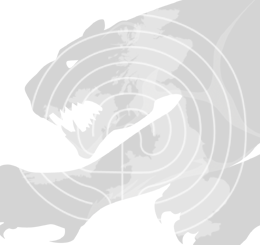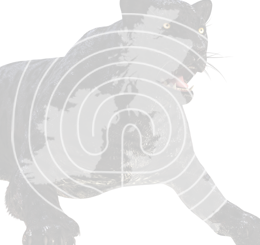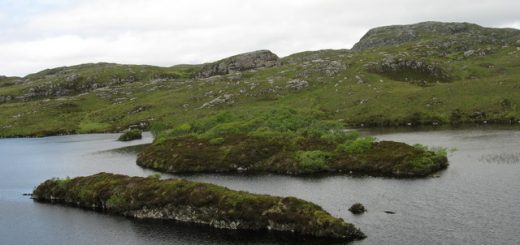The Loch Ness Monster
The most publicised and well known of the lake monsters, Nessie has captured the popular imagination. There are hundreds of sightings on record, which describe a roughly similar creature in and out of the water over a period of 200 years. However, the nature of these sightings has not been adequately resolved, and there are numerous theories to explain and explain away the evidence. The most popular of these being the survival of an aquatic dinosaur, which like most theories has many problems. To other people the answer is more metaphysical or psychological in origin, and to the more sceptical the answer lies in misinterpretation. But, after nearly 70 years of continuous sightings since the road around the loch was built, we are still no nearer an all-encompassing explanation.
Physically the loch is well suited to hiding a large creature, it is the largest fresh water loch in Britain at 22 1/2 miles long and 1/2 a mile broad at its widest. The loch has steep banks, which plunge to a depth of over eight hundred feet. Loch Ness is the largest in a string of lochs along the Great Glen Fault. The others being Loch Linnhe, Lock Oich and Loch Lochy. The Great Glen Fault separates Scotland in to two halves, millions of years ago they were two separate countries. The temperature of the loch stays at a constant value throughout the year, and its oligtrophic waters support a proportion of Salmon, plankton and other fish.
A Brief History of Sightings
One of the first recorded references to the monster harks back to 565 AD, when St Columba is said to have summoned a water monster in the River Ness, and banished it with the word of God. The Celtic Saints, especially in Cornwall, seemed quite fond of banishing and destroying water monsters and dragons, and the imagery may be symbolic of the early struggle between Christianity and Paganism.
During the seventeenth and 18th centuries folklore suggests that a Kelpie, the fearsome water horse of Scottish folklore, haunted the Loch. These were thought to haunt many bodies of water in the Highlands especially in the form of the Each Uisge . The Kelpie was seen in 1771 and 1889, but the well-known description of the monster does not appear until much later.
The first real modern sightings, the ones that started the public interest ball rolling were in 1933. At this time the road around the Loch was constructed, allowing wider public access and views from the roadside over the dull waters.
On April 14th 1933, Mr and Mrs Mackay, who owned an Inn at Drumnadriot, were driving home from Inverness when they spotted a creature in the water near Abriachan. It was about 12 to 15 feet in length, and seemed to roll and plunge in the water; the sighting lasted over a minute.
The Loch Ness Monster
The man who responsible for bringing the Mackay sighting to general public attention, was Alex Campbell, who was the water bailiff working for the Loch Ness Fisheries Board. He passed on the account, and details of his own sightings to the Inverness Courier in May 1933. In his own observations he had described the creature with “..a long tapering neck, about 6 feet long, and a smallish head with a serpentine look about it, and a huge hump behind which I reckoned was about 30 feet long. It was turning its head constantly.” He claimed to have seen the monster many more times. There has been some speculation that this sighting was to boost the publicity of the area, and in the months following the paper report, there were many more witnesses of the monster.
A depiction of the Loch Ness MonsterOne of the most famous sightings produced a photograph that was perceived as evidence of the monster, the so called ‘surgeons photo’ taken by R. K. Wilson a London surgeon in 1934. The photo has recently been revealed as fake.
In one of the first sighting of the creature out of the water, Arthur Grant was riding his motorbike back to his house in 1934, when he nearly ran into a creature crossing the road. In the light of the moon he could see a long necked animal with a small head, thick body and a long tapering tail. The creature seemed to be moving by the aid of flippers protruding from its body. The creature went back down to the loch, and disappeared into the water and out of his sight.
In April 1960 Tim Dinsdale filmed an object moving in the water, leaving behind it an obvious wake. The object was moving at around 10mph, examination of the film has been inconclusive.
The first real scientific investigation took place in June and July of 1960, and involved students from Oxford and Cambridge Universities. The loch was examined with echo sounding equipment and cameras attached to boats. There were a few minor sightings of ‘something’, and some of the return data from the echo sounder was ambiguous, but the project did not do anything to solve the mystery.
 In 1972 Robert H Rines, from the Academy of Applied Science in Boston, teamed up with the Loch Ness Investigations Bureau in an underwater survey using sonar and an underwater camera. On the 8th of August the camera captured an image of a paddle like object, which looked like a giant flipper from some unknown animal. The monster was given the name of Nessiteras Rhombopteryx, which, some people have pointed out, fits the words monster hoax within it quite easily. The sonar work also suggested that a large object was moving within the water.
In 1972 Robert H Rines, from the Academy of Applied Science in Boston, teamed up with the Loch Ness Investigations Bureau in an underwater survey using sonar and an underwater camera. On the 8th of August the camera captured an image of a paddle like object, which looked like a giant flipper from some unknown animal. The monster was given the name of Nessiteras Rhombopteryx, which, some people have pointed out, fits the words monster hoax within it quite easily. The sonar work also suggested that a large object was moving within the water.
In 1975 another deep water photo was taken, showing what is thought to be the head of a creature with two protrusions like horns coming from its head. The pictures were subsequently computer enhanced and it is difficult to say that they show anything animate.
1978 saw a joint project between the New York Times and the Academy of Applied Science. The loch was scanned thoroughly with sonar equipment but nothing significant was found.
In 1987 the Loch was the scene of a project named Operation Deepscan. More than 20 boats took part in surveying the loch with sonar equipment, and some ambiguous results were forthcoming. But again nothing definite was produced from the survey.
In more recent years there have been a number of sonar contacts with an object in the loch, and the sightings continue to the present day. There is not room in this brief history to include all sightings, but the web site linked at the bottom of this page is well worth visiting for those who wish to research further.
Some Theories
The most popular theory is that there is a small population of Plesiosaurs, (fish eating dinosaurs thought to have died out in the wave of extinction at the end of the Cretaceous period.) which have somehow managed to survive in the isolated loch when it became separated from the sea millions of years ago. That animals thought extinct can survive is proved by the re-discovery of the Coelacanth off the shores of Africa. But only a dead or live specimen of a plesiosaur will be able to justify this theory. It has been suggested that even a surviving population of stranded plesiosaurs would have become extinct due to inbreeding in such a small-enclosed environment as the loch. And then there is the question of the Ice Ages, when the loch would have under a mass of ice.
To counter this people have suggested an underwater cavern linking the Loch with the sea, and there is some evidence to suggest the existence of such caverns.
The creature may be a more mundane out of place animal such as a giant catfish or a sturgeon, some researchers have suggested a type of long necked seal, and even a giant eel. Other suggestions include a giant sea slug, a whale or a Manatee, although the latter two would have to surface much more than sightings suggest.
Some researchers think that the phenomenon has more to do with other paranormal sightings, and the theory that certain locations can have an effect upon human consciousness. The most recent theorising has linked the phenomena with earthlights and fault lines, and the effect of geophysical locations on the human mind. It is interesting to note that the Great Glen is one gigantic fault line, and the other three lochs along it are also reputed to house monsters.
There is always thought to have been something uncanny about the loch, and it has been suggested that the area is a ‘window area’ for strange phenomena, with its precident in folklore and legend. There is no doubt that many of the sightings seem to be something other than a physical creature, more akin to a phantom. What this suggests is anyone’s guess and to explain a mystery with a mystery is a little too vague.
The more sceptical viewpoint is that all of the sightings, photographs and other evidence are the result of misidentification of natural objects; hoaxing and publicity generation; and modern folklore and rumour. Many of the photos have been examined by experts, and have been denounced as fakes, speedboats, dogs or deer in the water, and other more mundane objects such as floating tree trunks. That many fakes have been perpetrated is not in question, even the surgeon’s photo, which was put forward as one of the best images of the creature has recently been exposed as a hoax.
The sighting at Loch Ness will no doubt continue and without any hard evidence the subject will continue to be debated by experts and laymen alike. Perhaps the real answer lies somewhere buried in the many facets of human nature.
For further research, consider the website Legend of Nessie.




A quick note
According to up-to-date paleontology plesiosaurs are technically not dinosaurs.
A main factor which has been downplayed in monster folklore is the proven fact that seals have been proven to enter the loch from time to time. Both the Gray seal and the Harp seal have been filmed and positevely identified by experts in the past ten years. A seal popping up its head in the middle of a loch may be an highly unusual experience even to trained biologists.
I’ve family which live on
I’ve family which live on the River Ness which flows out of the loch and into the Moray Firth and they often see seals in the river chasing salmon. It’s a lot more frequent occurence than people realise.
Re: The Loch Ness Monster
i live in inverness and have driven along side loch ness throw the day time and night time and have yet still to see anything that even looks like the loch ness monster but that does not mean it does not exist i do belive there must be something there will we ever find out that is the question ????
Re: The Loch Ness Monster
Best Nessie sighting?
http://www.dailymail.co.uk/news/article-2085009/Loch-Ness-Monster-3-hunters-compete-1k-prize-Best-Sighting-Year.html
Re: The Loch Ness Monster
Sonar picture of Nessie?
http://www.dailymail.co.uk/sciencetech/article-2132574/The-Loch-Ness-Monster-Sonar-picture-shows-serpent-like-creature-mysterious-loch.html